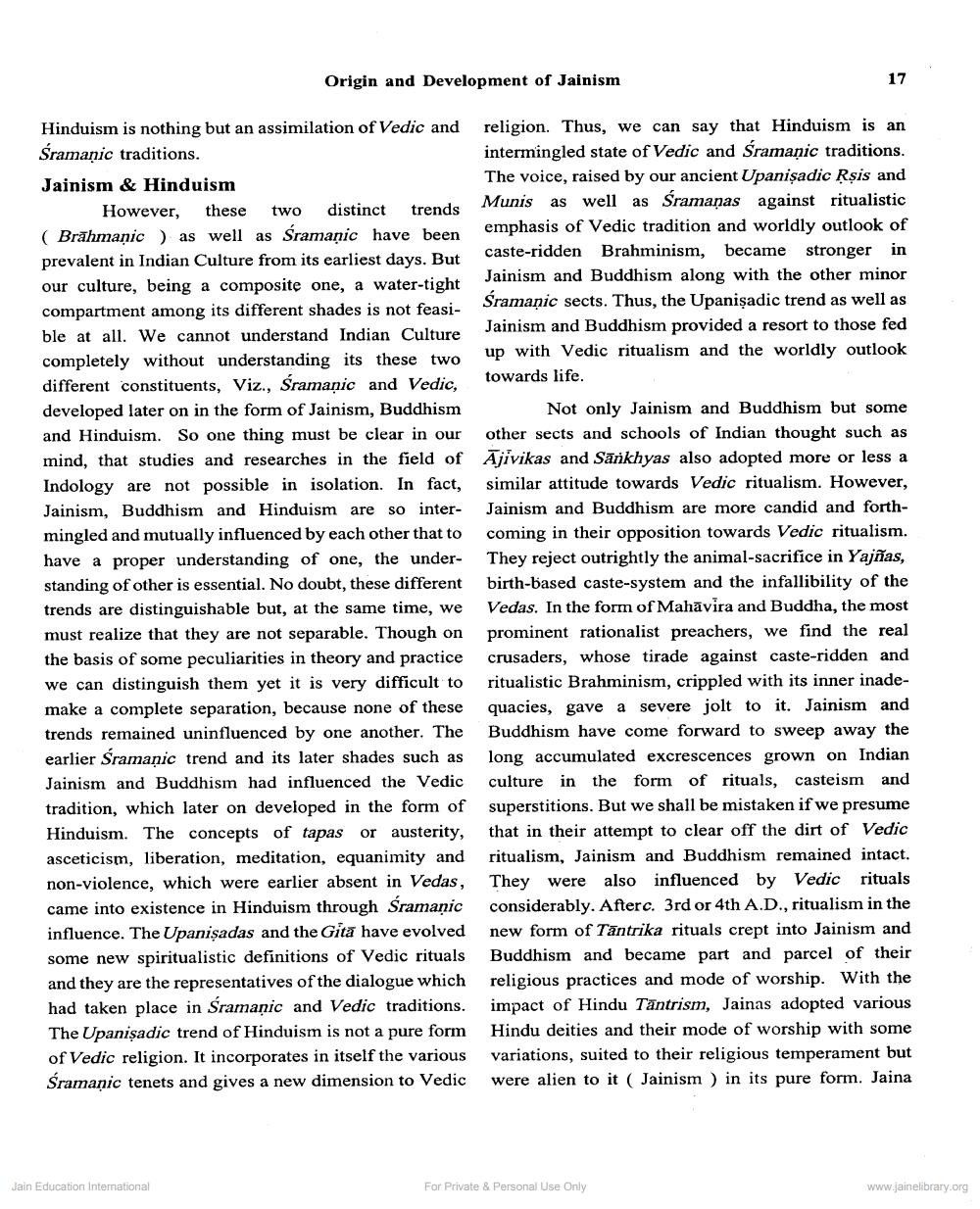________________
Origin and Development of Jainism
Hinduism is nothing but an assimilation of Vedic and Śramaņic traditions. Jainism & Hinduism
However, these two distinct trends ( Brāhmaṇic) as well as Sramanic have been prevalent in Indian Culture from its earliest days. But
But our culture, being a composite one, a water-tight compartment among its different shades is not feasi. ble at all. We cannot understand Indian Culture completely without understanding its these two
e two different constituents, Viz., Śramanic and Vedic, developed later on in the form of Jainism, Buddhism and Hinduism. So one thing must be clear in our mind, that studies and researches in the field of Indology are not possible in isolation. In fact, Jainism, Buddhism and Hinduism are so inter- mingled and mutually influenced by each other that to have a proper understanding of one, the under- standing of other is essential. No doubt, these different trends are distinguishable but, at the same time, we must realize that they are not separable. Though on the basis of some peculiarities in theory and practice we can distinguish them yet it is very difficult to make a complete separation, because none of these trends remained uninfluenced by one another. The earlier Sramanic trend and its later shades such as Jainism and Buddhism had influenced the Vedic tradition, which later on developed in the form of Hinduism. The concepts of tapas or austerity, asceticism, liberation, meditation, equanimity and non-violence, which were earlier absent in Vedas, came into existence in Hinduism through śramanic influence. The Upanişadas and the Gita have evolved some new spiritualistic definitions of Vedic rituals and they are the representatives of the dialogue which had taken place in Šramanic and Vedic traditions. The Upanişadic trend of Hinduism is not a pure form of Vedic religion. It incorporates in itself the various Sramaņic tenets and gives a new dimension to Vedic
religion. Thus, we can say that Hinduism is an intermingled state of Vedic and Sramanic traditions. The voice, raised by our ancient Upanişadic Rșis and Munis as well as Sramaņas against ritualistic emphasis of Vedic tradition and worldly outlook of caste-ridden caste-ridd
Brahminism, became stronger in Jainism and Buddhism along with the other minor Sramaņic sects. Thus, the Upanişadic trend as well as Jainism and Buddhism provided a resort to those fed up with up with Vedic ritualism and the worldly outlook towards life. to
Not only Jainism and Buddhism but some other sects and schools of Indian thought such as Ajivikas and Sankhyas also adopted more or less a similar attitude towards Vedic ritualism. However, Jainism and Buddhism are more candid and forthcoming in their opposition towards Vedic ritualism. They reject outrightly the animal-sacrifice in Yajñas, birth-based caste-system and the infallibility of the Vedas. In the form of Mahāvira and Buddha, the most prominent rationalist preachers, we find the real crusaders, whose tirade against caste-ridden and ritualistic Brahminism, crippled with its inner inadequacies, gave a severe jolt to it. Jainism and Buddhism have come forward to sweep away the long accumulated excrescences grown on Indian culture in the form of rituals, casteism and superstitions. But we shall be mistaken if we presume that in their attempt to clear off the dirt of Vedic ritualism, Jainism and Buddhism remained intact. They were also influenced by Vedic rituals considerably. Afterc. 3rd or 4th A.D., ritualism in the new form of Tantrika rituals crept into Jainism and Buddhism and became part and parcel of their religious practices and mode of worship. With the impact of Hindu Tantrism, Jainas adopted various Hindu deities and their mode of worship with some variations, suited to their religious temperament but were alien to it ( Jainism ) in its pure form. Jaina
Jain Education International
For Private & Personal Use Only
www.jainelibrary.org




